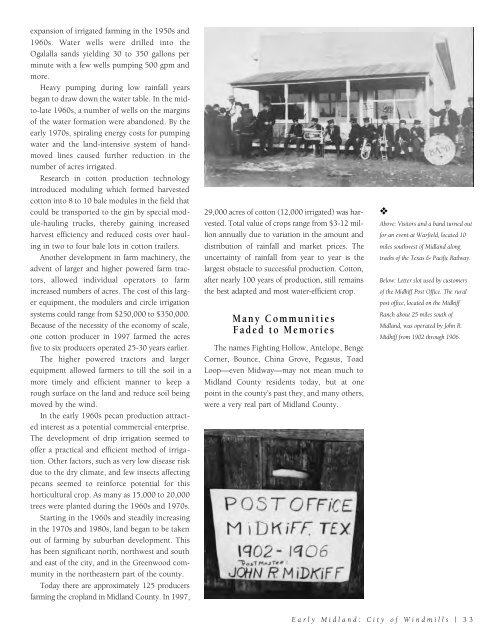Historic Midland
An illustrated history of the Midland County area, paired with the histories of companies, families and organizations that make the region great.
An illustrated history of the Midland County area, paired with the histories of companies, families and organizations that make the region great.
Create successful ePaper yourself
Turn your PDF publications into a flip-book with our unique Google optimized e-Paper software.
expansion of irrigated farming in the 1950s and<br />
1960s. Water wells were drilled into the<br />
Ogalalla sands yielding 30 to 350 gallons per<br />
minute with a few wells pumping 500 gpm and<br />
more.<br />
Heavy pumping during low rainfall years<br />
began to draw down the water table. In the midto-late<br />
1960s, a number of wells on the margins<br />
of the water formation were abandoned. By the<br />
early 1970s, spiraling energy costs for pumping<br />
water and the land-intensive system of handmoved<br />
lines caused further reduction in the<br />
number of acres irrigated.<br />
Research in cotton production technology<br />
introduced moduling which formed harvested<br />
cotton into 8 to 10 bale modules in the field that<br />
could be transported to the gin by special module-hauling<br />
trucks, thereby gaining increased<br />
harvest efficiency and reduced costs over hauling<br />
in two to four bale lots in cotton trailers.<br />
Another development in farm machinery, the<br />
advent of larger and higher powered farm tractors,<br />
allowed individual operators to farm<br />
increased numbers of acres. The cost of this larger<br />
equipment, the modulers and circle irrigation<br />
systems could range from $250,000 to $350,000.<br />
Because of the necessity of the economy of scale,<br />
one cotton producer in 1997 farmed the acres<br />
five to six producers operated 25-30 years earlier.<br />
The higher powered tractors and larger<br />
equipment allowed farmers to till the soil in a<br />
more timely and efficient manner to keep a<br />
rough surface on the land and reduce soil being<br />
moved by the wind.<br />
In the early 1960s pecan production attracted<br />
interest as a potential commercial enterprise.<br />
The development of drip irrigation seemed to<br />
offer a practical and efficient method of irrigation.<br />
Other factors, such as very low disease risk<br />
due to the dry climate, and few insects affecting<br />
pecans seemed to reinforce potential for this<br />
horticultural crop. As many as 15,000 to 20,000<br />
trees were planted during the 1960s and 1970s.<br />
Starting in the 1960s and steadily increasing<br />
in the 1970s and 1980s, land began to be taken<br />
out of farming by suburban development. This<br />
has been significant north, northwest and south<br />
and east of the city, and in the Greenwood community<br />
in the northeastern part of the county.<br />
Today there are approximately 125 producers<br />
farming the cropland in <strong>Midland</strong> County. In 1997,<br />
29,000 acres of cotton (12,000 irrigated) was harvested.<br />
Total value of crops range from $3-12 million<br />
annually due to variation in the amount and<br />
distribution of rainfall and market prices. The<br />
uncertainty of rainfall from year to year is the<br />
largest obstacle to successful production. Cotton,<br />
after nearly 100 years of production, still remains<br />
the best adapted and most water-efficient crop.<br />
Many Communities<br />
Faded to Memories<br />
The names Fighting Hollow, Antelope, Benge<br />
Corner, Bounce, China Grove, Pegasus, Toad<br />
Loop—even Midway—may not mean much to<br />
<strong>Midland</strong> County residents today, but at one<br />
point in the county’s past they, and many others,<br />
were a very real part of <strong>Midland</strong> County.<br />
❖<br />
Above: Visitors and a band turned out<br />
for an event at Warfield, located 10<br />
miles southwest of <strong>Midland</strong> along<br />
tracks of the Texas & Pacific Railway.<br />
Below: Letter slot used by customers<br />
of the Midkiff Post Office. The rural<br />
post office, located on the Midkiff<br />
Ranch about 25 miles south of<br />
<strong>Midland</strong>, was operated by John R.<br />
Midkiff from 1902 through 1906.<br />
Early <strong>Midland</strong>: City of Windmills | 33
















